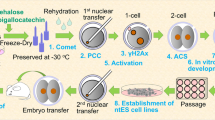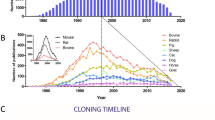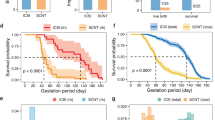Abstract
For many years, researchers cloning mammals experienced little success, but recent advances have led to the successful cloning of several mammalian species. However, cloning by the transfer of nuclei from adult cells is still a hit-and-miss procedure, and it is not clear what technical and biological factors underlie this. Our understanding of the molecular basis of reprogramming remains extremely limited and affects experimental approaches towards increasing the success rate of cloning. Given the future practical benefits that cloning can offer, the time has come to address what should be done to resolve this problem.
Key Points
-
Several mammalian species have been cloned by transferring nuclei from various adult somatic cells into enucleated oocytes.
-
The cloning procedure is still inefficient, and only one in a hundred of manipulated oocytes develop to adulthood.
-
Reasons for the low efficiency of cloning are largely unknown and are probably both technical and biological.
-
The incomplete or incorrect reprogramming of the donor nuclear genome — its inability to completely adapt and function in the new environment — is the most significant factor contributing to low cloning efficiency.
-
The cloning of large farm animals from genetically manipulated donor nuclei will have significant practical benefits.
-
The cloning of humans is prohibited because of safety reasons at present. However, therapeutic cloning and the production of individualized human embryonic stem cells for use in cell- and tissue-replacement therapies may have great importance in human medicine.
This is a preview of subscription content, access via your institution
Access options
Subscribe to this journal
Receive 12 print issues and online access
$189.00 per year
only $15.75 per issue
Buy this article
- Purchase on Springer Link
- Instant access to full article PDF
Prices may be subject to local taxes which are calculated during checkout




Similar content being viewed by others
References
Colman, A. Somatic cell nuclear transfer in mammals: Progress and applications. Cloning 1, 185–200 ( 1999).
Di Berardino, M. A. Genomic potential of differentiated cells (Columbia Univ. Press, New York, 1997).
Kolata, G. B. Clone: The road to Dolly, and the path ahead (William Morrow & Co., New York, 1998).
McLaren, A. Cloning: Pathways to a pluripotent future. Science 288, 1775–1780 (2000).
Sun, F. Z. & Moor, R. M. Nuclear transplantation in mammalian eggs and embryos. Curr. Top. Dev. Biol. 30, 147–176 (1995).
Wilmut, I., Campbell, K. & Tudge, C. The second creation (Headline Book Publishing, London, 2000).A personal and historical recollection of the events that led to the first cloning of mammals from adult cells.
Bromhall, J. D. Nuclear transplantation in the rabbit egg. Nature 258 , 719–722 (1975).
Watkins, J. F. Cell fusion in the study of tumor cells. Int. Rev. Exp. Pathol. 10, 115–141 ( 1971).
Graham, C. F. in Heterospecific Genome Interaction. The Wistar Institute Symposium (ed. Defendi, V.) 19–35 (The Wistar Institute Press, Philadelphia, 1969).
Rorvik, D. In his image: The cloning of a man (Lippincott, Philadelphia, 1978).
Modlinksi, J. A. Transfer of embryonic nuclei to fertilised mouse eggs and development of tetraploid blastocysts. Nature 273, 466– 467 (1978).
Modlinski, J. A., The fate of inner cell mass and trophectoderm nuclei transplanted to fertilized mouse eggs. Nature 292, 342– 343 (1981).
Illmensee, K. & Hoppe, P. C. Nuclear transplantation in Mus musculus: developmental potential of nuclei from preimplantion embryos . Cell 23, 9–18 (1981).
Tsunoda, Y. & Kato, Y. Not only inner cell mass cell nuclei but also trophectoderm nuclei of mouse blastocysts have a developmental totipotency . J. Reprod. Fertil. 113, 181– 184 (1998).
Wakayama, T., Tateno, H., Mombaerts, P. & Yanagimachi, R. Nuclear transfer into mouse zygotes. Nature Genet. 24, 108–109 (2000).
Zhou, Q., Boulanger, L. & Renard, J.-P. A simplified method for the reconstruction of fully competent mouse zygotes from adult somatic nuclei. Cloning 2, 35–44 (2000).
McGrath, J. & Solter, D. Nuclear transplantation in the mouse embryo by microsurgery and cell fusion. Science 220 , 1300–1302 (1983). The first description of a workable nuclear-transfer technique in mammals.
McGrath, J. & Solter, D. Completion of mouse embryogenesis requires both the maternal and paternal genomes. Cell 37, 179–183 (1984).
Barton, S. C., Surani, M. A. H. & Norris, M. L. Role of paternal and maternal genomes in mouse development . Nature 311, 374–376 (1984).References 18 and 19 established the principle of genomic imprinting.
McGrath, J. & Solter, D. Inability of mouse blastomere nuclei transferred to enucleated zygotes to support development in vitro. Science 226, 1317–1319 ( 1984).
Willadsen, S. M. Nuclear transplantation in sheep embryos. Nature 320 , 63–65 (1986). The first report of mammalian cloning using embryonic cells as nuclear donors.
Prather, R. S. et al. Nuclear transplantation in the bovine embryo: Assessment of donor nuclei and recipient oocyte. Biol. Reprod. 37 , 859–66 (1987).
Collas, P. & Barnes, F. L. Nuclear transplantation by microinjection of inner cell mass and granulosa cell nuclei. Mol. Reprod. Dev. 38, 264–267 ( 1994).
Collas, P., Balise, J. J. & Robl, J. M. Influence of cell cycle stage of the donor nucleus on development of nuclear transplant rabbit embryos. Biol. Reprod. 46, 492–500 ( 1992).
Campbell, K. H. S., Ritchie, W. A. & Wilmut, I. Nuclear-cytoplasmic interactions during the first cell cycle of nuclear transfer reconstructed bovine embryos: implications for deoxyribonucleic acid replication and development. Biol. Reprod. 49, 933–942 (1993).
Robl, J. M., Gilligan, B., Critser, E. S. & First, N. L. Nuclear transplantation in mouse embryos: Assessment of recipient cell stage . Biol. Reprod. 34, 733– 739 (1986).
Howlett, S. K., Barton, S. C. & Surani, M. A. Nuclear cytoplasmic interactions following nuclear transplantation in mouse embryos. Development 101, 915–923 (1987).
Tsunoda, Y. et al. Full-term development of mouse blastomere nuclei transplanted into enucleated two-cell embryos. J. Exp. Zool. 242 , 147–151 (1987).
Kono, T., Tsunoda, Y. & Nakahara, T. Production of identical twin and triplet mice by nuclear transplantation. J. Exp. Zool. 257, 214– 219 (1991).
Smith, L. C., Wilmut, I. & Hunter, R. H. F. Influence of cell cycle stage at nuclear transplantation on the development in vitro of mouse embryos. J. Reprod. Fertil. 84, 619–24 ( 1988).
Cheong, H.-T., Takahashi, Y. & Kanagawa, H. Birth of mice after transplantation of early cell-cycle-stage embryonic nuclei into enucleated oocytes. Biol. Reprod. 48, 958–963 (1993).
Otaegui, P. J., O'Neill, G. T., Campbell, K. H. S. & Wilmut, I. Transfer of nuclei from 8-cell stage mouse embryos following use of nocodazole to control the cell cycle. Mol. Reprod. Dev. 39, 147–152 (1994).
Cheong, H.-T., Takahashi, Y. & Kanagawa, H. Relationship between nuclear remodeling and subsequent development of mouse embryonic nuclei transferred to enucleated oocytes. Mol. Reprod. Dev. 37, 138–145 (1994).
Kwon, O. Y. & Kono, T. Production of identical sextuplet mice by transferring metaphase nuclei from four-cell embryos. Proc. Natl Acad. Sci. USA 93, 13010–13013 (1996).
Sims, M. & First, N. L. Production of calves by transfer of nuclei from cultured inner cell mass cells. Proc. Natl Acad. Sci. USA 91, 6143–6147 ( 1994).
Campbell, K. H. S., McWhir, J., Ritchle, W. A. & Wilmut, I. Sheep cloned by nuclear transfer from a cultured cell line. Nature 380, 64–66 ( 1996).References 35 and 36 established that nuclei from cultured cells could be used for cloning. Reference 36 demonstrated for the first time that nuclei from differentiated cells can support development to adults.
Solter, D. Lambing by nuclear transfer. Nature 380, 24–25 (1996).
Wilmut, I., Schnieke, A. E., McWhir, J., Kind, A. J. & Campbell, K. H. S. Viable offspring derived from fetal and adult mammalian cells. Nature 385, 810–813 (1997). The first report of a mammal cloned from an adult cell nucleus.
Wakayama, T., Perry, A. C., Zuccotti, M., Johnson, K. R. & Yanagimachi, R. Full-term development of mice from enucleated oocytes injected with cumulus cell nuclei. Nature 394, 369–374 ( 1998).
Kato, Y. et al. Eight calves cloned from somatic cells of a single adult. Science 282, 2095–2098 ( 1998).
Solter, D. Dolly is a clone and no longer alone. Nature 394, 315–316 (1998).
Ogura, A. et al. Production of male cloned mice from fresh, cultured, and cryopreserved immature Sertoli cells. Biol. Reprod. 62, 1579–1584 (2000).
Wakayama, T., Rodriguez, I., Perry, A. C. F., Yanagimachi, R. & Mombaerts, P. Mice cloned from embryonic stem cells. Proc. Natl Acad. Sci. USA 96, 14984 –14989 (1999).
Brind, S., Swann, K. & Carroll, J. Inositol 1,4,5-trisphosphate receptors are downregulated in mouse oocytes in response to sperm or adenophostin A but not to increases in intracellular Ca2+ or egg activation. Dev. Biol. 223, 251–265 ( 2000).
Jellerette, T., He, C. L., Wu, H., Parys, J. B. & Fissore, R. A. Downregulation of the inositol 1,4,5-trisphosphate receptor in mouse eggs following fertilization or parthenogenetic activation . Dev. Biol. 223, 238–250 (2000).
Deguchi, R., Shirakawa, H., Oda, S., Mohri, T. & Miyazaki, S. Spatiotemporal analysis of Ca2+ waves in relation to the sperm entry site and animal–vegetal axis during Ca2+ oscillations in fertilized mouse eggs. Dev. Biol. 218, 299–313 (2000).
Kuo, R. C. et al. NO is necessary and sufficient for egg activation at fertilization . Nature 406, 633–636 (2000).
Onishi, A. et al. Pig cloning by microinjection of fetal fibroblast nuclei. Science 289, 1188–1190 ( 2000).
Polejaeva, I. A. et al. Cloned pigs produced by nuclear transfer from adult somatic cells. Nature 407, 86–90 (2000).
Surani, M. A. Imprinting and the initiation of gene silencing in the germ line. Cell 93, 309–312 ( 1998).
Tilghman, S. M. The sins of the fathers and mothers: genomic imprinting in mammalian development . Cell 96, 185–193 (1999).
Latham, K. E. Mechanisms and control of embryonic genome activation in mammalian embryos . Int. Rev. Cytol. 193, 71– 124 (1999).
Schultz, R. M. The regulation and reprogramming of gene expression in the preimplantation embryo. Adv. Dev. Biochem. 5, 129– 164 (1999).
Kikyo, N., Wade, P. A., Guschin, D., Ge, H. & Wolffe, A. P. Active remodeling of somatic nuclei in egg cytoplasm by the nucleosomal ATPase ISWI. Science 289, 2360–2362 (2000).
Rothstein, J. L. et al. Construction of primary and subtracted cDNA libraries from early embryos. Meth. Enzymol. 225, 587– 610 (1993).
Renard, J.-P. et al. Lymphoid hypoplasia and somatic cloning. Lancet 353, 1489–1491 ( 1999).
Solter, D. Cloning and embryonic stem cells: a new era in human biology and medicine . Croatian Med. J. 40, 309– 318 (1999).
Lanza, R. P. et al. Extension of cell life-span and telomere length in animals cloned from senescent somatic cells. Science 288, 665–669 (2000).
Shiels, P. G. et al. Analysis of telomere lengths in cloned sheep. Nature 399, 316–317 ( 1999).
Wakayama, T. et al. Cloning of mice to six generations. Nature 407, 318–319 (2000).
Steinborn, R. et al. Mitochondrial DNA heteroplasmy in cloned cattle produced by fetal and adult cell cloning. Nature Genet. 25, 255–257 (2000).
Evans, M. J. et al. Mitochondrial DNA genotypes in nuclear transfer-derived cloned sheep. Nature Genet. 23, 90– 93 (1999).
Tamashiro, K. L. K., Wakayama, T., Blanchard, R. J., Blanchard, D. C. & Yanagimachi, R. Postnatal growth and behavioral development of mice cloned from adult cumulus cells . Biol. Reprod. 63, 328– 334 (2000).
Thomson, J. A. et al. Embryonic stem cell lines derived from human blastocysts. Science 282, 1145–1147 ( 1998).
Shamblott, M. J. et al. Derivation of pluripotent stem cells from cultured human primordial germ cells. Proc. Natl Acad. Sci. USA 95, 13726–13731 (1998).
Solter, D. & Gearhart, J. Putting stem cells to work. Science 283, 1468–1470 ( 1999). References 64, 65 and 66 describe the isolation of human embryonic stem cells, the isolation of human ebryonic germ cells and their possible therapeutic uses, respectively.
Munsie, M. J. et al. Isolation of pluripotent embryonic stem cells from reprogrammed adult somatic cell nuclei. Curr. Biol. 10, 989–992 (2000).
McCreath, K. J. et al. Production of gene-targeted sheep by nuclear transfer from cultured somatic cells. Nature 405, 1066 –1069 (2000).First report of cloning using cultured cell nuclei into which a foreign gene had been inserted at a predetermined chromosomal location. Proved that cloning technology could be used to produce large farm animals to serve as bioreactors.
Cibelli, J. B. et al. Cloned transgenic calves produced from nonquiescent fetal fibroblasts. Science 280, 1256– 1258 (1998).
Schnieke, A. E. et al. Human factor IX transgenic sheep produced by transfer of nuclei from transfected fetal fibroblasts. Science 278, 2130–2133 (1997).
Kubota, C. et al. Six cloned calves produced from adult fibroblast cells after long-term culture. Proc. Natl Acad. Sci. USA 97, 990–995 (2000).
Aldhous, P. Cloning's owners go to war. Nature 405, 610–612 (2000).
Ogura, A., Inoue, K., Takano, K., Wakayama, T. & Yanagimachi, R. Birth of mice after nuclear transfer by electrofusion using tail tip cells. Mol. Reprod. Dev. 57, 55–59 (2000).
Wakayama, T., Zuccotti, M., Johnson, K. R., Perry, A. C. F. & Yanagimachi, R. Full term development of mice from enucleated oocytes injected with cumulus cell nuclei. Nature 394, 369–374 ( 1998).
Wakayama, T. & Yanagimachi, R. Cloning of male mice from adult tail-tip cells. Nature Genet. 22, 127– 128 (1999).
Rideout, W. M. et al. Generation of mice from wild-type and targeted ES cells by nuclear cloning. Nature Genet. 24, 109– 110 (2000).
Author information
Authors and Affiliations
Related links
Related links
DATABASE LINKS
Inositol-1,4,5-trisphosphate receptor
FURTHER INFORMATION
In his Image: The Cloning of a Man
United States National Bioethics Advisory Commission's recommendations
ENCYCLOPEDIA OF LIFE SCIENCES
Nuclear transfer from established cell lines
Glossary
- CLONING EFFICIENCY
-
Cloning efficiency is calculated from the percentage of manipulated embryos that develops to adulthood, and reflects how successful or not a cloning experiment has been.
- THERAPEUTIC CLONING
-
The use of nuclear transfer to produce individually tailored human embryonic stem cells for tissue- and cell-replacement therapies.
- KARYOPLAST
-
An isolated donor nucleus, together with its envelope of cytoplasm and plasma membrane.
- CYTOPLAST
-
Enucleated oocyte or embryo (zygote) that is used as a nuclear recipient.
- POLAR BODY
-
The structure that is extruded from the oocyte during meiosis, which contains one haploid set of chromosomes.
- BIOREACTORS
-
Animals that are genetically engineered to produce proteins or macromolecules that are of use in human medicine.
- CYTOKINESIS
-
The division of the cytoplasm of a parent cell into daughter cells after nuclear division.
- OOCYTE ACTIVATION
-
This occurs when the binding of sperm to the egg cell membrane triggers a series of responses in the oocyte that prepare the oocyte for fertilization and block the entry of more sperm.
- CALCIUM TRANSIENTS
-
A series of repetitive oscillations in calcium concentration that move across the egg cytoplasm following sperm entry, which are essential for egg activation.
- MITOCHONDRIAL HETEROPLASMY
-
The presence of more than one type of mitochondrial DNA within the same cell.
Rights and permissions
About this article
Cite this article
Solter, D. Mammalian cloning: advances and limitations. Nat Rev Genet 1, 199–207 (2000). https://doi.org/10.1038/35042066
Issue Date:
DOI: https://doi.org/10.1038/35042066
This article is cited by
-
Activation-induced cytidine deaminase selectively catalyzed active DNA demethylation in pluripotency gene and improved cell reprogramming in bovine SCNT embryo
Cytotechnology (2016)
-
Induced Pluripotent Stem Cells from Human Hair Follicle Mesenchymal Stem Cells
Stem Cell Reviews and Reports (2013)
-
Mice generated after round spermatid injection into haploid two-cell blastomeres
Cell Research (2011)
-
Advances in Reprogramming Somatic Cells to Induced Pluripotent Stem Cells
Stem Cell Reviews and Reports (2010)



